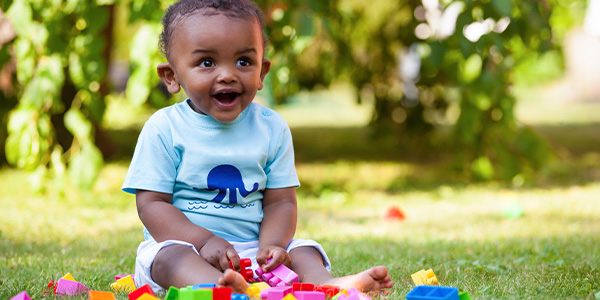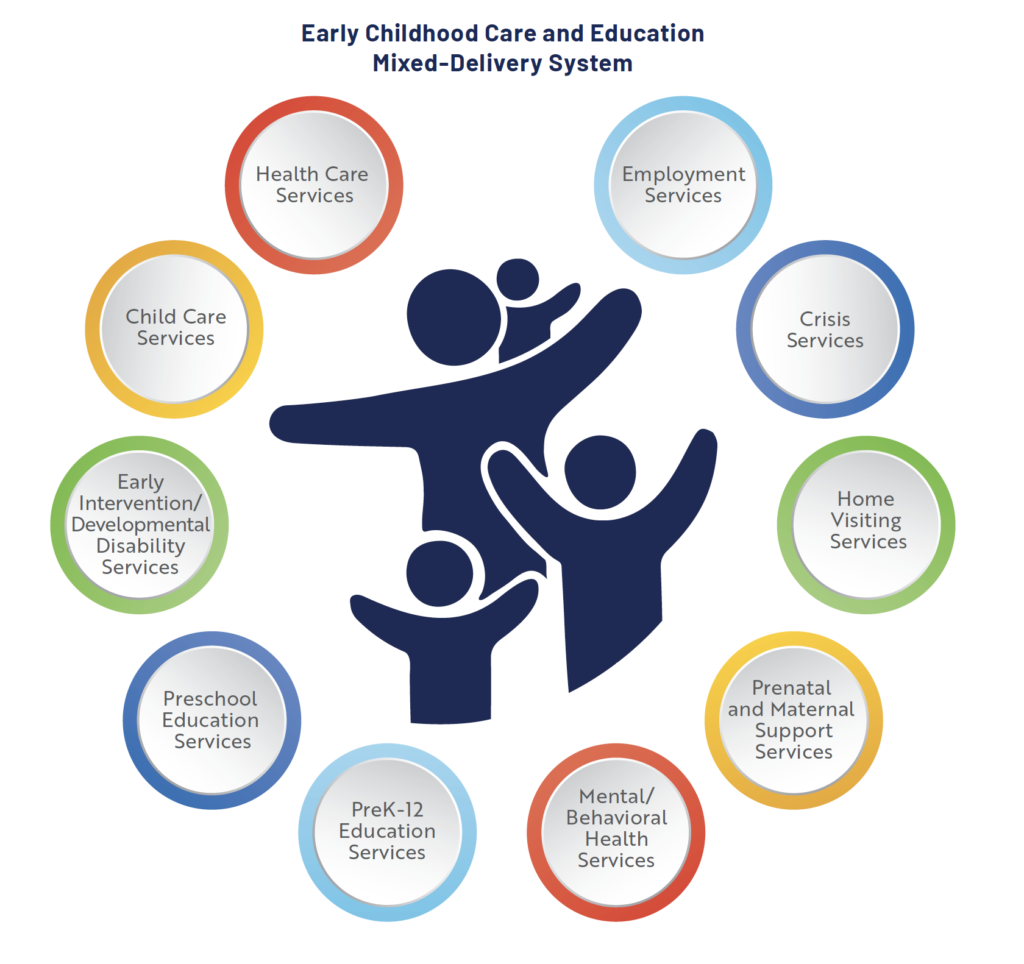Decades of scientific research underscore the importance of high-quality early childhood programs and experiences. We know that children make more than a million neural connections each second from birth to age 3, and these neurons form a brain architecture that can shape a child’s entire life trajectory. Early relationships, experiences, and environment all heavily influence this critical period of brain development. When young children experience stressful conditions – like economic hardship, neglect, or abuse – these negative experiences can disrupt the progress of their developing brains, which can in turn lead to lifelong challenges. With more than 90% of a child’s brain architecture developed by age five, there is no time to lose; our efforts to prepare young Kansans for success hinge on this critical early period of growth.
Investing early in a child’s life pays dividends for decades. Children who experience high-quality early childhood care and education have shown positive effects that last a lifetime. They tend to have better educational and health outcomes, higher graduation rates, and earn higher lifetime salaries. Additionally, high-quality early learning opportunities have been shown to lessen the harmful effects of economic insecurity, toxic stress, and trauma for children whose basic needs are not met early in life.

History and Milestones
Kansas has a long history of valuing early childhood as the foundation for a fulfilling life. We were the first state in the nation to establish a children’s trust fund in 1980. In 1999, Kansas lawmakers again demonstrated a strong commitment to our state’s future by enacting legislation to transform the original trust fund into the Kansas Endowment for Youth (KEY) Fund and the Children’s Initiatives Fund (CIF). This landmark legislation dedicated Kansas’ annual payments from the Tobacco Master Settlement Agreement to the KEY Fund and the CIF and created the Kansas Children’s Cabinet and Trust Fund (Children’s Cabinet). The Children’s Cabinet is charged5 with developing and implementing a coordinated and comprehensive early childhood care and education system,6 aligning and facilitating interagency cooperation, and advising the governor and legislature regarding investments in early childhood programs and services.
Since 2003, Kansas has had an Early Childhood Comprehensive Systems7 (ECCS) initiative in place, managed by the Kansas Department of Health and Environment. ECCS works to improve outcomes for child and family well-being by building systems at the state and local levels that support children birth through five and their families, specifically emphasizing the importance of developmental screenings and subsequent referrals to appropriate services. 3
In 2010, Kansas passed critically important child care legislation8 to protect Kansas children. Lexie’s Law, named for a Kansas toddler who suffered a preventable fatal injury while in child care, strengthened Kansas child care licensing requirements in an effort to prevent future tragedies. This built on the foundational child care policy of 1994.9

In 2015, the Kansas State Board of Education announced a new vision statement for education in Kansas: 10 Kansas leads the world in the success of each student. Thousands of Kansans shared their perspectives to shape this vision, and they recognized the critical importance of early childhood in student success. The State Board identified kindergarten readiness as one of five key outcomes to measure progress. Achieving this new vision will require early intervention, support, and resources that prioritize the needs of each individual child.
In 2019, key agency staff with responsibility for early childhood initiatives formed the All In For Kansas Kids Leadership Team to collaboratively strengthen the Kansas early childhood system. This team is made up of agency directors who have significant roles administering agency activities (Kansas Department for Children and Families, Kansas State Department of Education, Kansas Department of Health and Environment, and Kansas Children’s Cabinet and Trust Fund).
Today, we continue our journey toward a Kansas in which all children and families thrive. Fueled by an extensive and robust Needs Assessment conducted in 2019,12 Kansans are embarking on a process of regular and continual strategic planning, data gathering, feedback monitoring, and action.
What Do Our Youngest Kansans Need?
Our vision for early childhood in Kansas is that every child thrives. In December 2018, Kansas was awarded federal grant funding13 to help explore how closely reality aligns with that vision. We set out to better understand the opportunities and gaps of our current system and what Kansans envision for their children and families. This effort, detailed in our Needs Assessment report, uncovered two stark realities:
Geography Matters
Families’ experiences are profoundly shaped by where they live across the state and within communities. Geography impacts the availability and accessibility of early childhood services and supports, creating isolation and navigation barriers;
Basic Needs Are Not Being Met
Too many young Kansas children grow up in families where basic needs are not met. The struggle to meet basic needs such as food, housing, and health care challenges families’ ability to give their child a strong start in life.
These realities do not match our collective vision of Kansas as a place where every child thrives. Kansas is home to 196,826 children under the age of five, 14 and far too many of these children and their families continue to face issues of accessibility, availability, and navigation in their efforts to seek high-quality care and education during a child’s early years. At the same time, those committed to the care and education of our youngest Kansans15 face multiple obstacles that impact both the availability and quality of care and education.
Overcoming these challenges to effectively meet the needs of Kansas children and families requires a collective vision supported by attainable goals, concrete strategies, actionable tactics, and indicators of success. This All in for Kansas Kids Strategic Plan articulates that vision and charts the path forward.
Our Vision and Mission
The Kansas vision and mission for early childhood is outlined in the Children’s Cabinet Blueprint for Early Childhood (Blueprint).34 Our vision is that Kansas is a place where every child thrives. All children will have their basic needs met and have equitable access to quality early childhood care and education, so they are prepared to succeed in kindergarten and beyond. Our mission is to build a solid foundation for Kansas children and families. When children and families have a solid foundation of services and support, and the early childhood system is aligned and coordinated, we know children will thrive. Supportive relationships and healthy environments are critical during the early years, and a solid foundation in early childhood looks like this:
Pregnant women receive early prenatal care, education, and other family-centered services and supports.
Infants are born at healthy birth weights and receive optimal nutrition and nurturing.
Children receive physical and mental health screenings and interventions, are current with immunizations, and reach developmentally appropriate milestones.
Families can afford early childhood care and education options that meet their needs.
Early care and education professionals are competent, credentialed, and effective.
Child care facilities, early learning programs, and family support services are high-quality and able to meet the demand for services.
Children are in safe, stable, and nurturing relationships and environments, and no children experience economic hardship, abuse, or neglect.
The Blueprint for Early Childhood
Methods for ensuring a solid foundation in early childhood are presented in the Blueprint and organized into three building blocks: Healthy Development, Strong Families, and Early Learning. The Blueprint is our state’s framework for building a system where every child thrives.
The Blueprint recognizes the early years as a critical period for intervention that establishes a child’s foundation for school and life success. The document provides a common language, shared vision, and guidance for cross-sector collaboration in the delivery of high-quality programs and services. The Blueprint offers a common frame for making a difference in a child’s life and determining impact for each of the three building blocks. While the paths to success may vary, our vision of every child thriving and this Blueprint are intended to guide innovative program design, partnership development, sharing 7 of best practices, and tracking of long-term outcomes for children and families. Together, the Blueprint and the All in for Kansas Kids Strategic Plan align the activities of agencies and providers in our state’s mixed-delivery system around common goals.

View the complete All in for Kansas Kids Strategic Plan, or navigate sections using the menu to the left.
